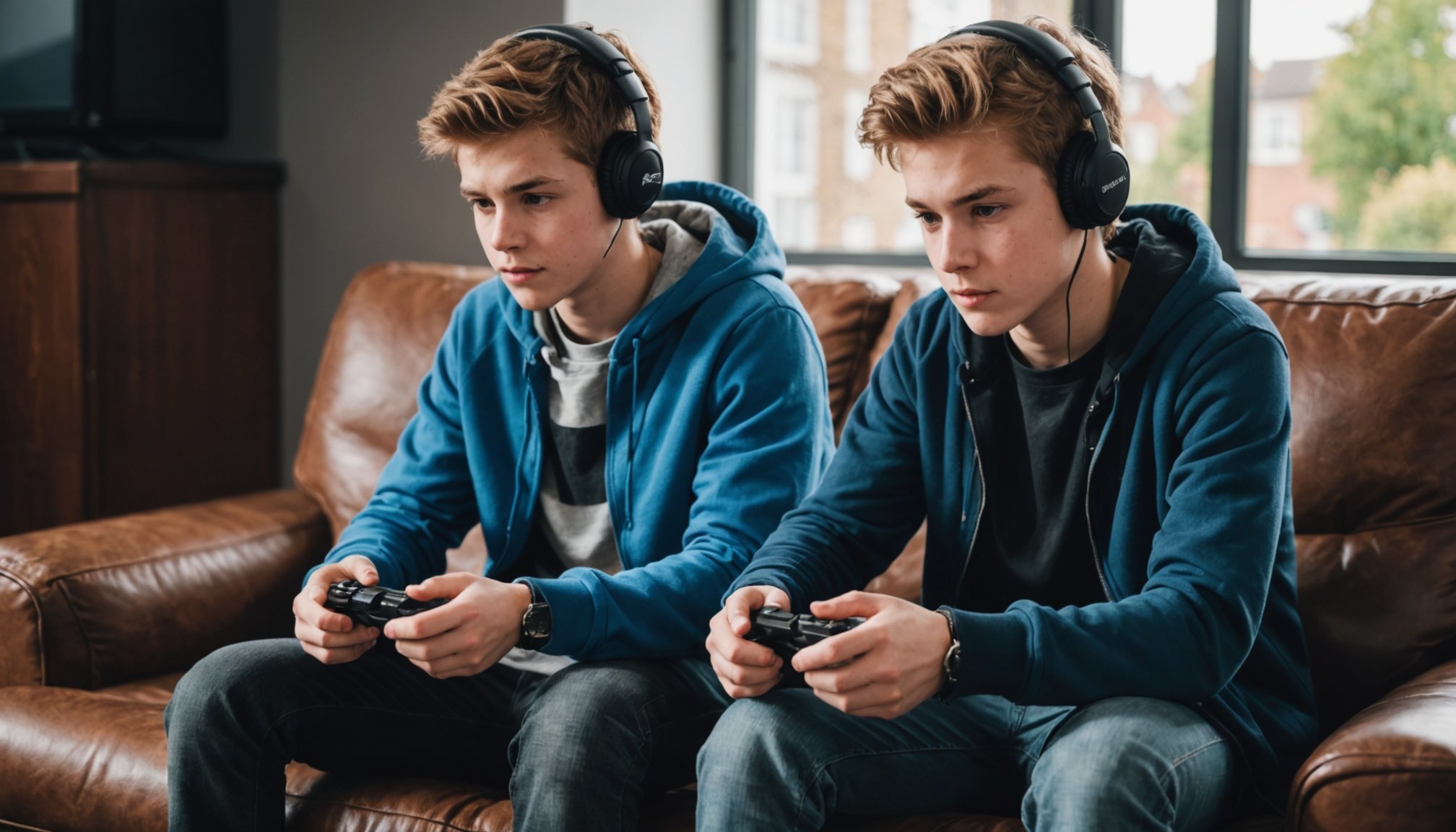Exploring the Health Risks of Extended Sitting Among Teen Gamers in the UK: A Comprehensive Guide
The Rise of Screen Time and Its Impact on Health
In the UK, as in many other parts of the world, the lives of teenagers are increasingly dominated by screens. Whether it’s for education, entertainment, or social interaction, the time spent on devices has skyrocketed, particularly among young gamers. This shift has significant implications for both physical and mental health.
The Physical Health Consequences
Extended sitting, a common behavior among teen gamers, is linked to a range of physical health problems. Studies have shown that prolonged sedentary behavior can lead to musculoskeletal disorders, such as “text neck syndrome” or “tech neck,” which is becoming increasingly prevalent among young people.
Also to see : Unlocking the Link: How Sleep Quality Influences Weight Control in the UK
Dr. Raghvendra Ramdasi, a neurosurgeon from Jaslok Hospital, highlights the alarming rise in such cases: “In 2023, I treated 125 patients with severe neck pain and related issues. The number rose to 252 this year so far. Of these, 180 are between 14 and 24 years of age.”
Here are some key physical health risks associated with extended sitting:
Also read : Top Exercises to Enhance Posture for UK Office Workers Struggling with Back Pain
- Musculoskeletal Disorders: Poor posture while gaming or using devices can lead to chronic pain conditions like myofascial pain syndrome, affecting the muscles and fascia.
- Cardiovascular Disease: For every hour of sitting above 10 hours, the risk of cardiovascular disease increases by 15%.
- Obesity: Excessive gaming time often replaces physical activity, contributing to childhood obesity and related health issues.
Mental Health Implications
The impact of extended screen time on mental health is equally concerning. Social psychologist Jonathan Haidt, in his book The Anxious Generation, argues that the surge in screen time has coincided with a mental health crisis among young people.
Social Deprivation and Sleep Deprivation
Haidt identifies four foundational harms triggered by the new “phone-based childhood”: social deprivation, sleep deprivation, attention fragmentation, and addiction.
- Social Deprivation: Children who spend more time on social media are less likely to engage in face-to-face interactions, which are crucial for social development. This can lead to increased rates of depression and anxiety.
- Sleep Deprivation: High social media use is linked to shorter sleep duration, longer sleep latency, and more mid-sleep awakenings. Teenagers, who need more sleep than adults, suffer from poor concentration and information retention due to sleep deprivation.
Addiction and Mental Health Outcomes
Video games, in particular, are designed to be addictive, targeting the pleasure-seeking part of the brain that produces dopamine. This can lead to pathological gaming, characterized by symptoms such as:
- Anxiety and Insomnia: Pathological gamers often develop anxiety, insomnia, and social isolation due to a lack of social interaction.
- Depression and Self-Esteem Issues: Excessive gaming can result in depression, social phobia, and lower self-esteem, creating a vicious cycle where these issues exacerbate the inclination to game more.
The Role of Video Games in Health Outcomes
Video games are a significant component of screen time for many teenagers. Here are some detailed findings on their impact:
Negative Effects of Video Games
- Aggression in Teens: Exposure to violent video games is a causal risk factor for increased aggressive behavior. A comprehensive meta-analysis involving over 100 research papers supports this finding.
- Addiction to Gaming: Video games are designed to be addictive, leading to pathological gaming that can result in anxiety, insomnia, social isolation, and depression.
- Poor Academic Performance: Spending long hours playing video games can affect academic performance. Studies show that heavy online players are more likely to get poor grades compared to light users.
Practical Advice for Parents and Teenagers
Given the strong evidence linking extended screen time to various health problems, it is crucial to implement strategies that balance screen time with physical activity and other healthy behaviors.
Setting Limits and Encouraging Physical Activity
- Screen Time Limits: Establish strict limits on the duration of device use. For example, the Smartphone Free Childhood (SFC) movement advocates for delaying smartphone use until children are at least 14 years old.
- Balancing Activity: Encourage a mix of physical activity, exercise, and sports to offset the sedentary nature of gaming. Dr. Siddharth Shah suggests that “strict limitations on the duration of device use and balancing optimal activity” are key to mitigating health risks.
Ergonomic Practices
- Proper Posture: Ensure that teenagers maintain proper posture while using devices. Dr. Abhishek Srivastava emphasizes the importance of ergonomics, such as keeping the computer monitor at the right height and positioning the keyboard just below elbow level.
- Hybrid Desks: Consider using hybrid desks that allow for both sitting and standing, as this can facilitate more movement and reduce the risks associated with prolonged sitting or standing.
Community and Policy Initiatives
There are several community and policy initiatives aimed at addressing the health risks associated with extended screen time.
The Smartphone Free Childhood Movement
- Delayed Smartphone Use: The SFC movement encourages parents to delay buying smartphones for their children until they are at least 14 years old. This initiative has gained significant support, with over 37,000 parents and more than 8,100 schools signing the pact.
Local Initiatives
- St Albans Example: The city of St Albans in Hertfordshire has taken a proactive approach by announcing plans to become the first British city to go smartphone-free for under 14s. This initiative includes joint letters from primary schools encouraging parents to delay smartphone purchases for their children.
The health risks associated with extended sitting among teen gamers in the UK are multifaceted and alarming. It is essential for parents, policymakers, and the community to work together to implement strategies that promote a healthy balance between screen time and physical activity.
By understanding the physical and mental health implications of extended screen time, we can take proactive steps to mitigate these risks. Here is a summary of key findings and advice:
Key Findings
| Health Risk | Description | Evidence |
|---|---|---|
| Musculoskeletal Disorders | Poor posture leads to chronic pain conditions like myofascial pain syndrome. | Dr. Raghvendra Ramdasi’s study |
| Cardiovascular Disease | Prolonged sitting increases cardiovascular disease risk by 15% per hour above 10 hours. | Study on stationary behavior |
| Mental Health Issues | Social deprivation, sleep deprivation, attention fragmentation, and addiction are linked to screen time. | Jonathan Haidt’s The Anxious Generation |
| Addiction to Gaming | Video games are designed to be addictive, leading to pathological gaming and related mental health issues. | Tom Kersting’s observations |
Practical Advice
- Set Screen Time Limits: Establish strict limits on device use.
- Encourage Physical Activity: Balance screen time with physical activity and sports.
- Practice Good Ergonomics: Ensure proper posture and use hybrid desks.
- Support Community Initiatives: Engage with movements like the Smartphone Free Childhood initiative.
By taking these steps, we can help young people navigate the digital age in a healthier and more balanced way.











